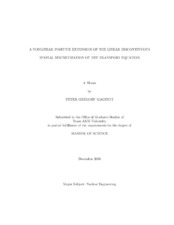| dc.description.abstract | Linear discontinuous (LD) spatial discretization of the transport operator can
generate negative angular flux solutions. In slab geometry, negativities are limited
to optically thick cells. However, in multi-dimension problems, negativities can even
occur in voids. Past attempts to eliminate the negativities associated with LD have
focused on inherently positive solution shapes and ad-hoc fixups. We present a new,
strictly non-negative finite element method that reduces to the LD method whenever
the LD solution is everywhere positive. The new method assumes an angular flux
distribution, e , that is a linear function in space, but with all negativities set-to-
zero. Our new scheme always conserves the zeroth and linear spatial moments of the
transport equation. For these reasons, we call our method the consistent set-to-zero
(CSZ) scheme.
CSZ can be thought of as a nonlinear modification of the LD scheme. When the
LD solution is everywhere positive within a cell, psi csz = psi LD. If psi LD < 0 somewhere
within a cell, psi csz is a linear function psi csz with all negativities set to zero. Applying
CSZ to the transport moment equations creates a nonlinear system of equations
which is solved to obtain a non-negative solution that preserves the moments of the
transport equation. These properties make CSZ unique; it encompasses the desirable
properties of both strictly positive nonlinear solution representations and ad-hoc
fixups. Our test problems indicate that CSZ avoids the slow spatial convergence
properties of past inherently positive solutions representations, is more accurate than ad-hoc fixups, and does not require significantly more computational work to solve
a problem than using an ad-hoc fixup.
Overall, CSZ is easy to implement and a valuable addition to existing transport
codes, particularly for shielding applications. CSZ is presented here in slab and rect-
angular geometries, but is readily extensible to three-dimensional Cartesian (brick)
geometries. To be applicable to other simulations, particularly radiative transfer,
additional research will need to be conducted, focusing on the diffusion limit in
multi-dimension geometries and solution acceleration techniques. | en |


